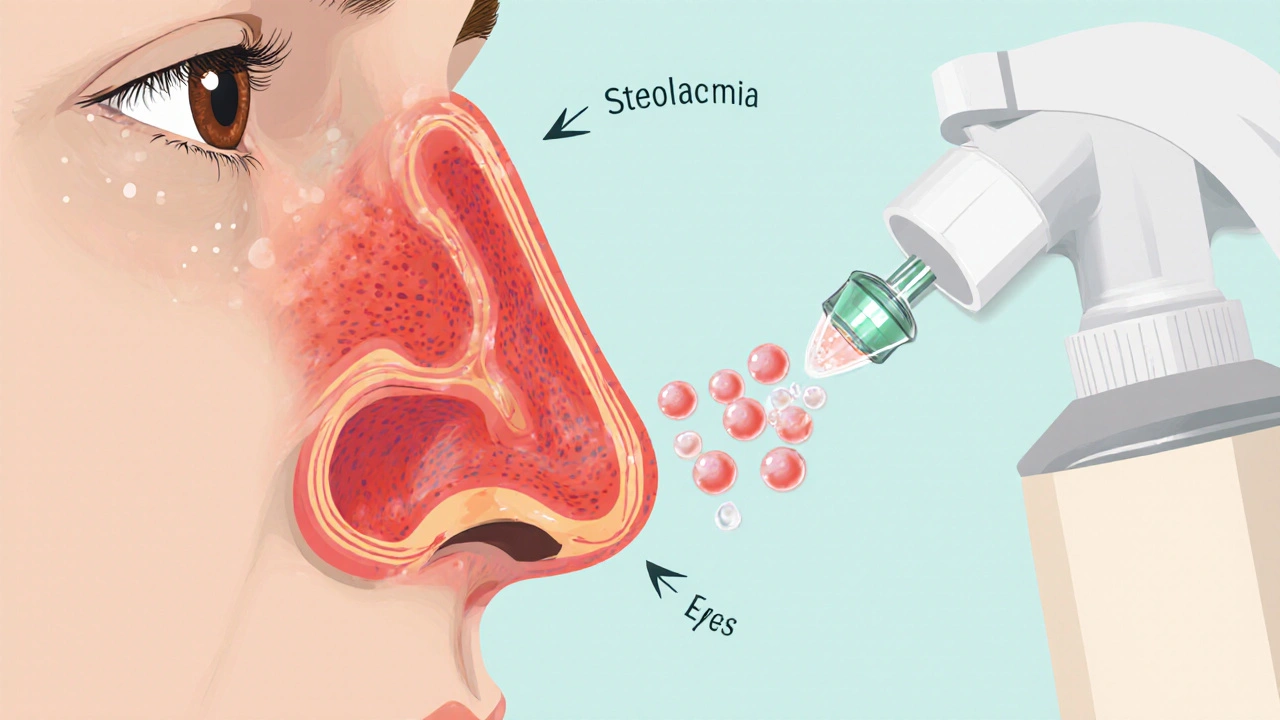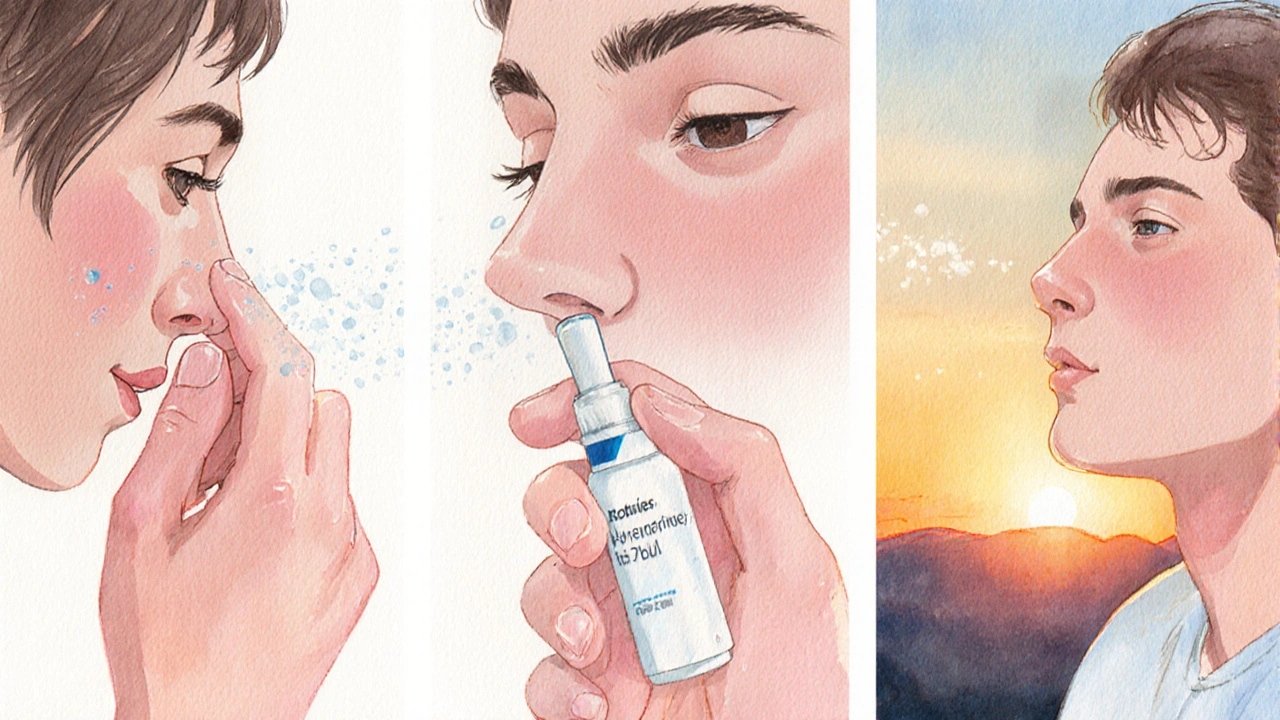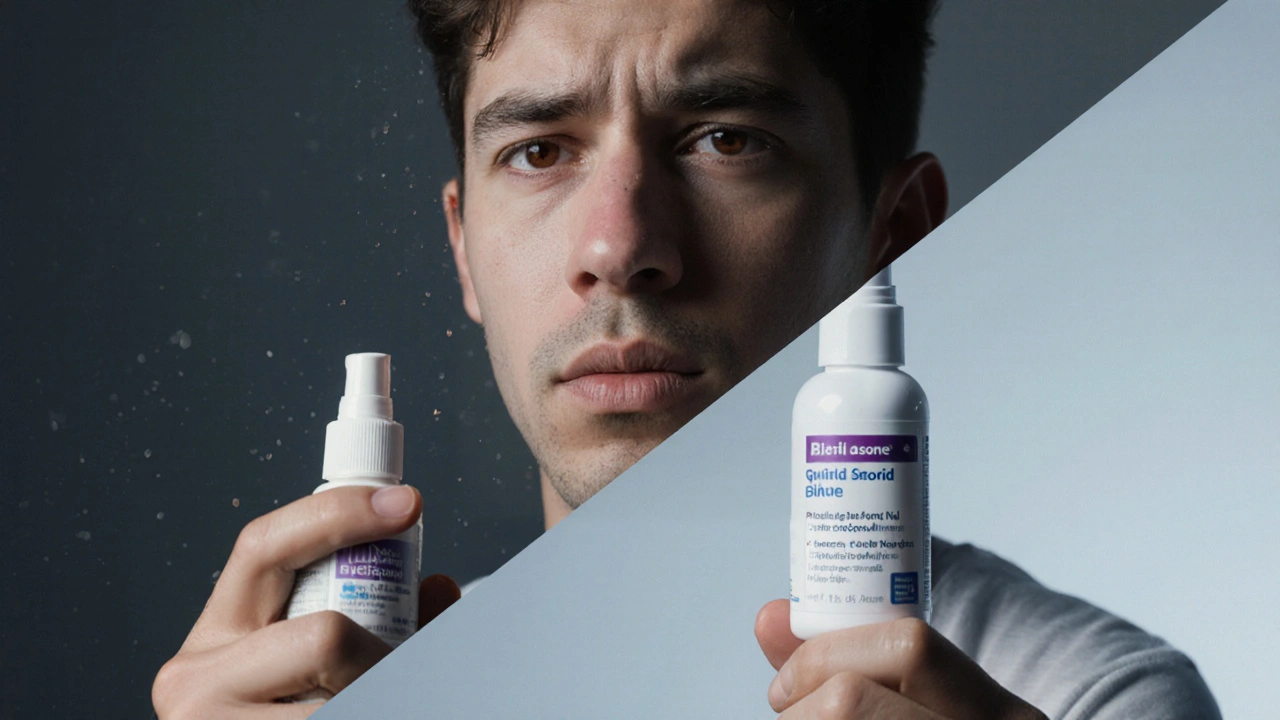Nasal Steroid Effectiveness Calculator
Expected Results
When a nose feels completely blocked and the eyes are red and watery, most people reach for a quick fix like a decongestant spray or eye drops. While those options can give temporary relief, they often don’t address the underlying inflammation. nasal steroids are intranasal corticosteroid sprays that reduce swelling in the lining of the nose and, indirectly, the eyes. By calming the inflamed tissue, they tackle both the stuffy nose and the watery, itchy eyes at the source.
TL;DR:
- Nasally applied corticosteroids shrink inflamed nasal tissue, easing congestion.
- Reduced nasal inflammation also lowers the eye‑surface irritation that causes red, watery eyes.
- Common ingredients include fluticasone, mometasone, and budesonide-most are prescription, but a few are OTC.
- Start with 1-2 sprays per nostril daily; effects appear after 2-3 days, full relief in a week.
- Side‑effects are rare but can include mild nose dryness or nosebleeds; proper technique minimizes risk.
Why nasal inflammation matters
Most people think a blocked nose is just a matter of mucus buildup, but the real culprit is swelling of the nasal mucosa. This swelling is part of the body’s response to allergens, viruses, or irritants. The same inflammatory mediators that expand the blood vessels in the nose can travel through the tear ducts, making the eyes red and watery. In medical terms, the condition is often called allergic rhinitis - a chronic inflammation of the nasal passages caused by allergens such as pollen, dust mites, or pet dander. When the nasal lining stays inflamed, the tear‑producing glands become overactive, leading to allergic conjunctivitis - the classic red, itchy, watery eye symptom.
How nasal steroids work
Intranasal corticosteroids act like a targeted anti‑inflammatory pill that you spray directly onto the swollen tissue. The steroid molecule penetrates the nasal epithelium and binds to intracellular receptors, which then turn off genes that produce inflammatory proteins (like histamine and cytokines). With those chemicals suppressed, blood vessels constrict, mucus production drops, and the airway opens up. Because the eyes share the same inflammatory pathway through the nasolacrimal system, calming the nose also calm the eyes.
Choosing the right spray - a quick comparison
| Active ingredient | Brand name(s) | Prescription? | Onset of relief | Typical daily dose |
|---|---|---|---|---|
| Fluticasone propionate | Flonase, Flonase Sensimist | OTC (US) | 2-3 days | 1-2 sprays per nostril |
| Mometasone furoate | Nasonex | Prescription (most markets) | 1-2 days | 2 sprays per nostril |
| Budesonide | Rhinocort, Rhinocort Aqua | OTC (some regions) | 3-5 days | 1 spray per nostril |
| Triamcinolone acetonide | Nasacort Allergy 24HR | OTC | 2-4 days | 2 sprays per nostril |
All four options reduce inflammation, but they differ in potency, price, and how quickly you notice a change. If you need a fast start, mometasone furoate often shows relief within a day. For a budget‑friendly, widely available choice, fluticasone propionate is the go‑to.
How to use a nasal steroid correctly
- Gently blow your nose to clear excess mucus. \n
- Shake the bottle - this ensures an even mix of the steroid particles.
- Close one nostril with a fingertip.
- Insert the tip into the opposite nostril, aiming the spray toward the outer side of the nasal passage (away from the nasal septum).
- Press the pump while breathing in gently through your nose.
- Repeat for the other side, then avoid blowing your nose for at least 10 minutes.
Following this technique minimizes the chance of a dry septum or nosebleed, which are the most common side‑effects.

When to expect results and how long to stay on treatment
Most users notice a reduction in congestion after 2-3 days, but full control of both nose and eye symptoms often takes about a week. Because nasal steroids work by modifying the body’s inflammatory response, stopping treatment abruptly can lead to a rebound of symptoms. Most doctors recommend a minimum of 4-6 weeks for chronic allergic rhinitis, after which you can discuss tapering or switching to a “maintenance” lower‑dose regimen.
Safety profile and common concerns
The safety record of intranasal corticosteroids is solid. Because the dose delivered to the body is tiny (usually less than 200µg per day), systemic side‑effects are rare. The most frequently reported local issues are:
- Mild nose dryness - can be helped with saline spray.
- Occasional nosebleeds - often due to improper spray angle.
- Throat irritation - rinse your mouth after use if the spray drips back.
Patients with glaucoma, cataracts, or uncontrolled diabetes should talk to a physician before starting a nasal steroid, as a small amount of the drug can enter the bloodstream.
Combining nasal steroids with other allergy tools
For many sufferers, a single approach isn’t enough. Here’s a quick guide on what works well with nasal steroids:
- Antihistamine eye drops - agents like ketotifen or olopatadine target the eye directly and provide rapid relief while the steroid works on the root cause.
- Oral antihistamines - second‑generation options (cetirizine, loratadine) help control daytime itching without causing drowsiness.
- Saline nasal rinses - a daily saline spray or neti pot clears allergens and keeps the nasal lining moist, enhancing steroid absorption.
- Avoid using over‑the‑counter decongestant sprays (oxymetazoline) for more than three days, as they can cause rebound congestion that defeats the steroid’s benefit.
Who should NOT use nasal steroids
If you have a recent nasal surgery, facial trauma, or an active fungal infection in the sinuses, hold off on steroids until cleared by a specialist. Children under 4years old generally aren’t prescribed these sprays unless a pediatric allergist deems it necessary.
Quick troubleshooting guide
| Problem | Likely Cause | Fix |
|---|---|---|
| Still congested after 5 days | Incorrect spray technique or severe allergy load | Review technique; add saline rinse; consider stepping up dose with doctor |
| Eye redness persists | Separate ocular allergy not fully covered | Introduce antihistamine eye drops |
| Nose bleeds | Spray hitting the septum | Aim spray toward the outer wall; use a humidifier |
| Throat irritation | Medication dripping down | Spit out excess; rinse mouth after use |

Frequently Asked Questions
Can I use nasal steroids for a common cold?
A cold causes inflammation, so a short course of a nasal steroid can reduce congestion, but it won’t cure the virus. Use them for a few days and stop once symptoms fade.
How long does it take to see improvement?
Most people notice lighter congestion within 2‑3 days; optimal relief for both nose and eyes usually appears after 5‑7 days of consistent use.
Are there any long‑term risks?
Long‑term systemic effects are minimal because only a tiny amount enters the bloodstream. The main concern is local irritation, which can be managed with proper spray technique and regular saline rinses.
Do children need a different dosage?
Yes. For kids aged 2‑11, doctors usually recommend half the adult dose (often one spray per nostril once daily) and may prefer a milder steroid like budesonide.
Can I take a nasal steroid and an oral antihistamine together?
Absolutely. Combining the two targets both the inflammatory pathway (steroid) and the histamine response (antihistamine), giving faster, more complete symptom control.
What should I do if I miss a dose?
Just take the missed spray as soon as you remember, then continue with your regular schedule. Skip it if it’s almost time for the next dose - don’t double up.
By keeping the nasal passages calm, you keep the eyes calm too. If you’ve been battling a blocked‑up nose and red, watery eyes for weeks, give a nasal steroid a proper trial - it may be the missing piece in your allergy toolkit.

Hey folks, just wanted to point out that consistency is key when using nasal steroids – aim for the same time each day and give it a few weeks before deciding if it’s working. A gentle saline rinse before each spray can help the medicine coat the lining better.